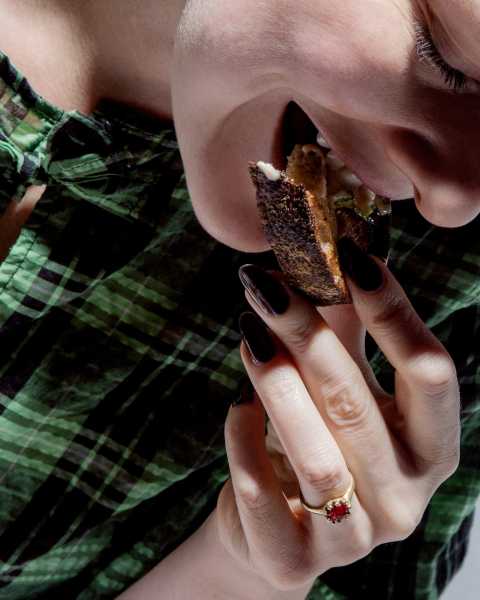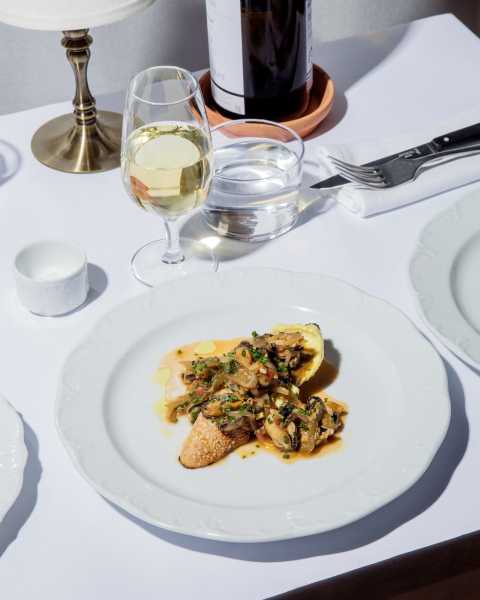
Save this storySave this storySave this storySave this storyYou’re reading the Food Scene newsletter, Helen Rosner’s guide to what, where, and how to eat. Sign up to receive it in your in-box.
One of my many rules of restaurant-going is: if you see an unsexy vegetable given pride of place on a menu, order it. We pretty much know what to expect when a kitchen touts its Brussels sprouts—dollars to doughnuts, they’ll show up crispy and maple-syruped—or carrots (roasted, goat cheese), or beets (roasted, goat cheese, nuts), but when a chef refuses to play the hits, and instead goes for the produce-aisle deep cuts, something exciting is likely afoot. This principle explains why, while eating dinner at April Bloomfield’s spiffy new Fort Greene restaurant, Sailor, I found myself facing down a round, softball-size parcel, smooth-sided and inky purple, doused in a sauce of a similar hue. It was stuffed radicchio—starring one of the most curmudgeonly of vegetables, bitter and fibrous, almost always a supporting act—and therefore, by statute, a nonnegotiable dish to order.
Sailor
228 Dekalb Ave., Brooklyn
(Dishes $6-$38.)
In the right hands, radicchio is among the kitchen’s great transformation artists—it softens, with heat and care, into something mellow and tender—and there are few better hands than those of Bloomfield. As a chef, she is perhaps best known as a meat whisperer; she was a primary architect of the lard-and-offal era of the late two-thousands and twenty-tens. But true fans (and owners of her second, vegetable-focussed, cookbook) know that she is arguably even more adept with ingredients beyond the animal. Slicing into the sphere of wrapped radicchio leaves, I discovered an interior of fragrant rice studded with firm, creamy borlotti beans. Taking a bite of this mixture, bathed in a wine sauce—which was rich and emulsified and, I learned later, vegan—was like sinking into a quicksand of warmth and flavor. The leaves of the radicchio imparted a lingering hint of bitterness, a scalpel through the savory roundness of everything else. This is the dish, I thought to myself—the dish of the restaurant, perhaps the dish of the year. Following the rules has rarely led me wrong.
Bloomfield’s previous tenure in New York, as the chef-partner of the restaurateur Ken Friedman, came to an end, in 2017, after she was accused of insufficiently protecting her staff from the alleged sexual predation of Friedman and Mario Batali, a Spotted Pig investor. (Friedman settled harassment claims against him; Batali denied assaulting anyone but acknowledged that his behavior was “deeply inappropriate.” Bloomfield has said that coming to terms with her failures in addressing employee concerns “blew my psyche wide open.”) After ending her association with Friedman, Bloomfield spent a few years as a wandering cook, stepping into kitchens in L.A., Connecticut, Rhode Island, and the U.K., where she is from, before landing at Sailor. Her partner now is the restaurateur Gabriel Stulman, whose constellation of West Village restaurants (as well as the NoHo gem Jolene) is of the warmly lit, tightly packed, casually refined variety that makes you feel marvellous simply for being in them. The way he tells it, getting Bloomfield to sign on to Sailor was a moon shot. Then, to his surprise, she said yes.

A bite of the brandade.

A dish of shaved celery, Parmigiano cheese, olives, and anchovies is an homage to San Francisco’s legendary Zuni Café.
The partnership is canny: Bloomfield, for all her prodigious talent, has never been much for publicity; Stulman, although supremely gifted at creating dining rooms with good vibes, has never quite managed to get his restaurants famous for their food. At Sailor, he works the subtly nautical-themed space—maritime paintings, wooden built-ins, brass fittings—beaming his earthy charisma upon diners, pouring tastes of amaro, chatting amiably about how he had to open this place, in the former home of a takeaway Middle Eastern spot, now that he’s moved with his family to Brooklyn and wants to continue being able to walk to work. Perhaps to no one’s surprise, the partnership between him and Bloomfield has resulted in a restaurant that is intensely, almost freakishly wonderful, especially given that (dare I admit it?) chefs of Bloomfield’s calibre still tend to stick to Manhattan.
In the Bloomfieldian way, Sailor’s menu speaks with self-effacing directness: Toast with Green Sauce, Smoked Pork Shoulder with Fennel. This ingredient-oriented understatement feels a bit Londonish (Bloomfield spent formative years at the River Café) and a bit Bay Area-ish. One dish on Sailor’s menu is an explicit homage to San Francisco’s legendary Zuni Café: an austere plate containing a small pile of shaved celery, a few squares of Parmigiano cheese, a little cluster of tiny purple olives, and two skinny anchovy fillets, whose pungent oil ties everything together. Platings are straightforward, service attentive but informal. The magic is performed in the kitchen, and the reveal occurs only in the eating. The green sauce on the toast is an entire verdant meadow of unexpected herbs like marjoram, a shivery punch of anchovy and capers, the peppery astringency of exquisite olive oil. The pork shoulder, a gargantuan hunk of meat, melts against the knife, all but merging into the caramelized-anise softness of the roasted fennel wedge alongside.
Helen, Help Me!
E-mail your questions about dining, eating, and anything food-related, and Helen may respond in a future newsletter.
You can take the food at face value (it’s delicious; all you really need to do is eat it), but the menu also offers a bit of cerebral playfulness, if you’re into that sort of thing. Mussel toast—a thick wedge of bread spread with aioli and piled high with shelled molluscs and doused in a tomato-tinged sauce—is effectively a bowl of cioppino (there’s the Bay Area, again) minus the broth. Radishes, poached to magenta brilliance in fruity lambic beer, are draped with translucent sheets of melting guanciale, delivering the sharp-and-fat cleverness of raw radishes with butter and salt (an iconic dish at the erstwhile Prune, another evident influence on Bloomfield’s menu), but softened, allowing unexpected elements to come to the fore. The classics on the menu, too, are evidence of a cook in complete control: a salt-cod brandade, briny and smooth, gets jazzed up with a swirl of safety-vest-orange pepper oil, whose floral sweetness plays up the jolie-laide salinity of the fish puree. The roasted chicken for two is excellent, with burnished skin and tender, herb-infused flesh. It is served directly on top of a pile of Parmesan-roasted potatoes and garlicky braised chard, which absorb all the golden drippings and nearly eclipse the pleasures of the bird itself. Bloomfield understands, better than most, that the chicken might be what you ask for when you order, but the everything-else about it matters just as much, maybe even more.

The mussel toast is effectively cioppino minus the broth.

Wine is stored behind the marble-topped service station.
There are only eight tables in the dining room at Sailor. The front room is reserved for walk-ins—a few seats at the bar, two tidy wooden booths—but to get a reservation you need to be very lucky, very famous, or very quick-fingered on Resy. The ceiling, dark and beamed, hangs over the room like a night sky; servers two-step curvaceous paths between tables, the kitchen, and a large, marble-topped service station that takes up much of the room, at which they spoon out portions of olives and roasted nuts, pour a glass of port, or slice a portion of the fig tart that lives atop the counter, under a glass cloche. Behind them looms a full wall of wine bottles, telegraphing both abundance and easy accessibility. (Wine is served in sommelier-style tasting glasses, which are smaller and narrower than the usual all-purpose goblet, a further nod to Sailor’s thesis of casual opulence.) An enormous mirror, mounted at an angle above the back of the room, reflects a God’s-eye view of the flow of servers and diners, the tops of heads and the sacred geometry of round plates and glasses snugly fit onto rectangular tables.
There is a strange magic in seeing a chef of Bloomfield’s status cooking in a place like this, on an unassuming corner in a mostly residential neighborhood. Sailor is a destination restaurant dressed up as a neighborhood spot—which is maybe the best kind of restaurant there is. Bloomfield seems to be there every night, and I felt a jolt of happiness when, on my first visit, I saw her back there, framed in the doorway to the kitchen, trim and short-haired, radiating focus. I also felt a twinge of guilt, and maybe ambivalence. She is one of the greatest cooks of her generation, and one of the most under-heralded; in a still viciously sexist business, she is the rare woman who made it to the very top. She is also a chef who, by many accounts, turned her eye away from the monstrous misdeeds of the men who employed her and a person who, after those men slunk away out of the public eye, retreating to the comfort of their money and their summer homes, had to keep working. What makes Sailor a success, besides the quality of its fare, is that it doesn’t feel like Bloomfield is making a play for redemption, or taking a shot at glory. It feels like she’s doing what she always wanted to be doing: cooking fantastic food, putting it on a plate, and then handing it off to someone else—someone like Stulman—to make sure all the fittings and fixtures are in place for the lucky people eating it. ♦
Sourse: newyorker.com






